by Diahan Southard | May 27, 2017 | 01 What's New, Genealogy Giants Websites, MyHeritage
 The new MyHeritage Collection Catalog is making the site even easier to use. Read our 3 favorite uses for the new MyHeritage Collection Catalog, and a description of how MyHeritage counts its records.
The new MyHeritage Collection Catalog is making the site even easier to use. Read our 3 favorite uses for the new MyHeritage Collection Catalog, and a description of how MyHeritage counts its records.
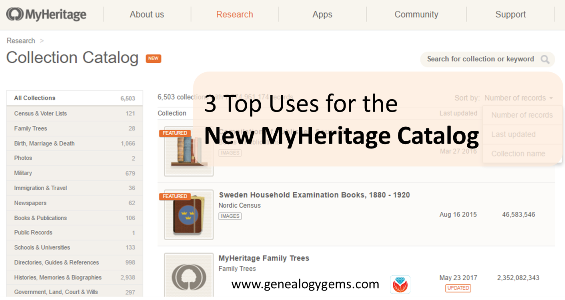
The new MyHeritage Collection Catalog has just been released, and is dedicated to searching records collections on the site. It’s a public catalog, available whether you are a subscriber or not, so now you can easily see whether MyHeritage may have the historical records you need.
It’s a public catalog, available whether you are a subscriber or not!
“The new Collection Catalog provides a useful listing of the collections on SuperSearch and is a gateway to the vast historical treasure trove of 7.8 billion records currently offered by MyHeritage,” says a MyHeritage press release. “The catalog lists our 6,503 main collections and excludes tiny collections that have fewer than 500 records each.” (Those may be added to the catalog later on.)
Here are 3 top uses we see for the new MyHeritage Collection Catalog:
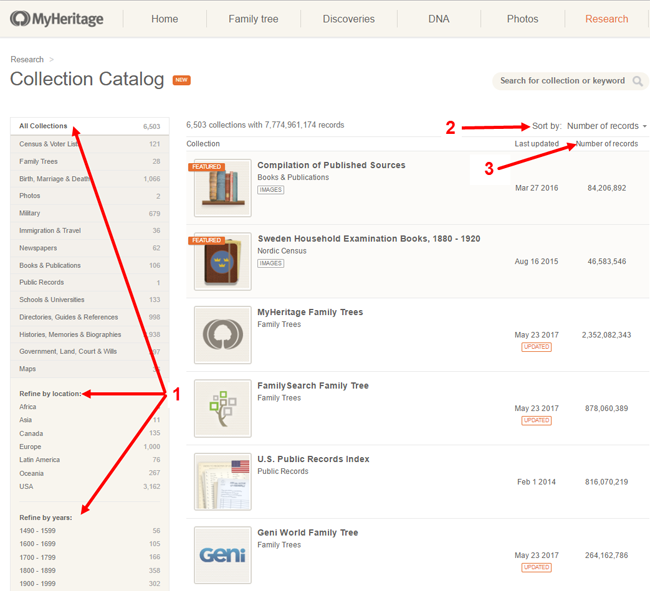
1. Look for specific record types for a particular place and time period. Use the left side menu to select record types, locations and time periods. Within many of those, you’ll be able to choose more specific subcategories. You can also do keyword searches if you’re generally looking for particular kinds of records (“newspaper” or “church”).
2. See what’s new on the site, or what collections have been recently updated. To see what’s been added or updated lately, roll over Sort by and select “Last updated.” You’ll also see a little tag on any collections that are new or have been recently updated. This helps you to know whether you’re seeing the most recent data available, particularly in collections they index from other websites, such as the FamilySearch Tree or Geni World Family Tree.
3. See how many records are in a collection. This may help you determine how comprehensive a particular database might be, and compare how many records for a particular place are on their site.
Speaking of record counts, MyHeritage also shared a description of how they count records. I’m really encouraged to see a major records site do this and I hope this trend continues! In our newest quick reference guide, Genealogy Giants: Comparing the 4 Major Websites, we talk about how difficult it is to compare record content on different genealogy websites because there’s no uniform standard for counting them, and they don’t all define their counting methods alongside their site statistics. Here’s MyHeritage’s description of how they count records:
“In structured collections, such as census records, birth, and marriage records, each individual name is counted as one record. For example, a marriage document naming both the bride and groom is counted as two records. Nicknames or aliases are not counted as additional records. In family trees, each tree profile is counted as one record, even when it is available in more than one language. Each photo is counted as one record. In unstructured collections, such as newspapers or yearbooks, each page is counted as one record even though it may include hundreds of names. We count each page as a single record because we don’t want to inflate the record count by guessing.” (MyHeritage previously published this information in a 2014 blog post.)
Getting the Most from MyHeritage
Here at Genealogy Gems we strive to help you get the most out of the genealogy websites you choose to use in your research. In the case of MyHeritage, we’ve got two jam-packed quick reference guides like no others on the market:
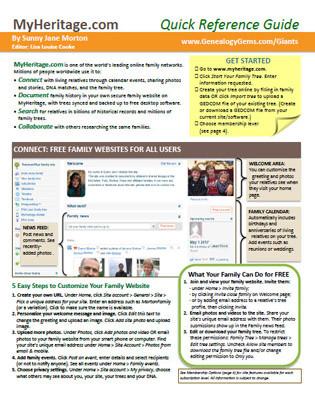 MyHeritage Quick Reference Guide: Newly Updated in 2017!
MyHeritage Quick Reference Guide: Newly Updated in 2017!
This guide shows you how to:
- create a family website on MyHeritage (and help your relatives use it for free),
- build your family tree,
- research records and others’ trees,
- get the most from the built-in search tools,
- test or upload your DNA and work with DNA matches,
- quickly navigate the website, and choose the best membership plan (free or paid) for your needs.
Genealogy Giants: Comparing the 4 Major Websites: NEW in 2017
This comprehensive guide helps you answer the question, “Which genealogy records websites should I use?” You’ll learn:
 How knowing about all four websites can improve your family history research
How knowing about all four websites can improve your family history research- How the sites stack up numerically for historical records, names in trees, DNA profiles, site users, site languages and subscription costs
- Unique strengths of each website and cautions for using each
- What to keep in mind as you evaluate record content between sites
- Geographic record strengths: A unique table has an at-a-glance comparison for 30+ countries
- How to see what kinds of records are on each site without subscribing
- How family trees are structured differently at these websites—and why it matters
- Privacy, collaboration, and security options at each site
- How DNA testing features differ at the two websites that offer it
- What you can do with free guest accounts at each website
- Subscription and free access options
Thanks for sharing this post with others who will want to know about the new MyHeritage Catalog! You are a Gem!
by Lisa Cooke | Feb 20, 2017 | 01 What's New, DNA, Kids |
DNA testing for kids is a great way to spark their interest in their heritage, while teaching science, math, geography, and more. Consider these reasons and start with the budget-friendly option of an autosomal test.
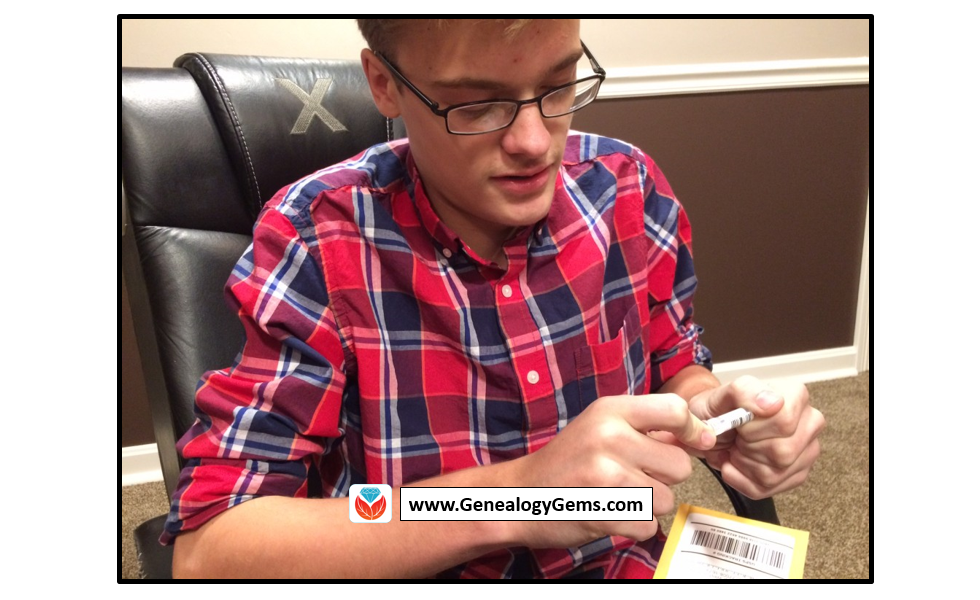
According to a 2010 study out of Emory University, if we want to encourage kids toward an activity that will positively impact them, we should steer them toward family history. The researchers reported, “Children who know stories about relatives who came before them show higher levels of emotional well-being.”
Now, I know I don’t need to convince you of this. You are already sold on genealogy. But let’s explore how DNA testing might be able to help you share your love of family history with your children and grandchildren.
Why Try DNA Testing for Kids
Since you know this is me, the genetic genealogist talking, you can probably guess what I’ll suggest for getting kids interested in family history. DNA testing is a great way to personally and physically involve them. There is the tangible process of taking the sample at home, and the marvel at how such a simple act can produce the amazing display of our ethnicity results. Since each of us is unique, it will be fun for them to compare with you and other relatives to see who-got-what-from-who. This will naturally lead to questions about which ancestor provided that bit of Italian or Irish, and wham! You’ll be right there to tell them about how their 5th great-grandfather crossed the ocean with only the clothes on his back, determined to make a new start in a new land.

If there are parts of the ethnicity report you can’t explain, use that as a hook to encourage them to start digging and to find out why you have that smattering of eastern European or Southeast Asian. Taking them for a tour of the DNA match page, you can show them how they share 50% of their DNA with their sister (whether they like it or not!) and how they share 25% with their grandparent!
DNA test results give kids a totally unique look at their personal identity with technology that is cutting edge. Looking at their DNA test results can turn into a math lesson, a science lesson, a geography lesson, a lesson on heredity or biology, or a discussion on identity. DNA is the perfect introduction to the wonders that genealogy can hold, especially for children.
A Warning and Caution
As with all DNA testing pursuits, this one should not be taken lightly, even with all of its benefits.
An important word to parents: Be sure to keep unintentional consequences in the forefront of your mind. This includes the possibility of revealing family secrets. Talk with your spouse and make sure you are both on the same page. In the end, this is your decision.
An important word to grandparents and other relatives: DNA testing is a parent’s decision. Even though you’re passionate about preserving the family’s history and the benefits of including children are numerous, you must obtain parental consent if you are not the parent.
More About Autosomal DNA Testing for Kids
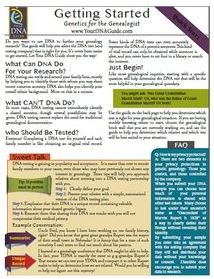 Click here to learn more about my series of how-to videos (available to Gems fans for a special price) or start your kids’ or grandkids’ DNA journey with two of my genetic genealogy quick guides. The first is a great overview and the second talks about autosomal testing which is a good test for genetic genealogy beginners.
Click here to learn more about my series of how-to videos (available to Gems fans for a special price) or start your kids’ or grandkids’ DNA journey with two of my genetic genealogy quick guides. The first is a great overview and the second talks about autosomal testing which is a good test for genetic genealogy beginners.
by Lisa Cooke | Feb 15, 2013 | 01 What's New, Conferences, Who Do You Think You Are?
I’m busy packing my bags getting ready to make the trip from California to London for my third appearance at Who Do You Think You Are? Live in London.

Here I am in last year’s experts panel
I’ll be teaching some of my favorite classes (sorry, they are already sold out, but I look forward to seeing those of you who have tickets there):
- Friday 3/22 at 2:30 pm Ultimate Google Search Strategies
- Saturday 3/23 at 11:00 Turn Your iPad (and Tablet Too!) into a Family History Powerhouse
If you don’t get a chance to attend my classes don’t fret, because I have a free ebook for you called 5 Fabulous Google Search Strategies for the Family Historian that will jump-start your research. It’s available for free when you sign up for my free Genealogy Gems e-Newsletter.
One of the best parts about the event for me is meeting all of you! And this year that will be easier than ever. When I’m not teaching you can find me at the Family ChartMasters booth (#12)
There’s so much to look forward to at this years event. Whether you’re new to tracing your family tree or a seasoned researcher, it’s packed with genealogy experts, informative workshops, over 160 specialist exhibitors and celebrities from the UK television series to help you with your own family history search. Is it any wonder that Who To You Think You Are? Live made it on my 50 Family History Favorites list (which includes my top 5 conference picks!) Here the list in the brand new free Genealogy Gems Podcast Episode 151.
It is often said that “bigger is better” here in America, but in the case of family history conferences, the British have won the “super-sized” title. As an American genealogist, when I walk into the immense Olympia convention centre, I feel like a kid in a candy shop. Contained within those walls is more energy, more color (LOVE the hot pink carpeting!), more vendors and more genealogists than just about anywhere else. You certainly don’t have to have British roots to benefit from attending. This is my third year and I look forward to it as much as the first time.
So many of the Genealogy Gems Podcast’s 1 million downloads have been from the UK that it’s like “old home week” for me. Hope to see you there!
by Lisa Cooke | Dec 19, 2013 | 01 What's New, images, Video
Can 100 years be packed into 10 minutes? This YouTube video attempts to do it!
(Warning: contains some graphic images)
The video also illustrates how the movie camera has captured our triumphs and tragedies for over 100 years.
Do you have old family movies? Consider posting them on YouTube with relevant descriptions that will help others find and watch them. Just like old photos, old film can play a ![]()
 significant role in our family history, and the Internet provides a forum for sharing them. If you have a free Google account (perhaps you use Gmail or another Google service) then you can use that account to activate your own YouTube channel.
significant role in our family history, and the Internet provides a forum for sharing them. If you have a free Google account (perhaps you use Gmail or another Google service) then you can use that account to activate your own YouTube channel.
You can learn how to get your free YouTube channel up and running at my upcoming class at RootsTech2014 called How to Use YouTube for Family History: Setting Up Your Own YouTube Channel (RT1508) Thursday, February 6 at 10:30 AM in Room: Ballroom H
by Lisa Cooke | Aug 24, 2012 |
Virtual Conference Special Package 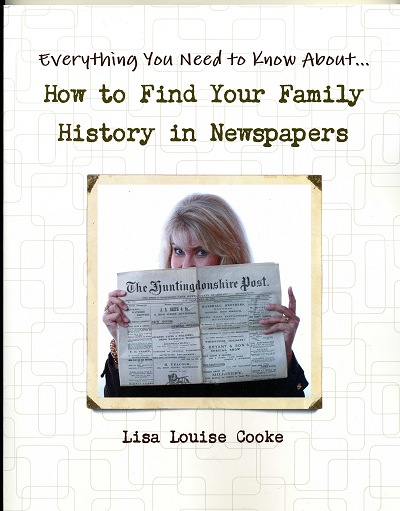
Package Includes:
How to Find Your Family History in Newspapers (paperback, retail $24.95)
and the digital PDF ebook of the book for FREE! (emailed to the address you provide within 24 hours of payment.)
U.S. Shipping & Handling for paperback book: $2.95
Please email us for assistance or if you have questions.
Hurry! Offer expires March 10, 2014
Save 20% off of a 1 year Genealogy Gems Premium Membership 
(Retail $29.95) Coupon Code: SAVE20
and for a limited time get the bonus ebook gift:
Lisa Louise Cooke’s 84 Best Tips, Tricks and Tools buy medication in spain from Family Tree Magazine
Click Here to become a Member
Membership Includes:
Exclusive over 100 Premium Podcast Episodes, and over a dozen videos of some of Lisa’s most popular classes including:
- Evernote for genealogy
- Genealogy on the Go with the iPad
- Get the Scoop on Your Ancestors with Newspapers
- Ultimate Google Search Strategies
- and more.
Click Here to become a Member
Sign up for the free Genealogy Gems email newsletter:
Enter your email in the box in the column on the right and receive the
free e-book: 5 Fabulous Google Search Strategies for the Family Historian by Lisa Louise Cooke
 The new MyHeritage Collection Catalog is making the site even easier to use. Read our 3 favorite uses for the new MyHeritage Collection Catalog, and a description of how MyHeritage counts its records.
The new MyHeritage Collection Catalog is making the site even easier to use. Read our 3 favorite uses for the new MyHeritage Collection Catalog, and a description of how MyHeritage counts its records.
 MyHeritage Quick Reference Guide: Newly Updated in 2017!
MyHeritage Quick Reference Guide: Newly Updated in 2017! How knowing about all four websites can improve your family history research
How knowing about all four websites can improve your family history research








